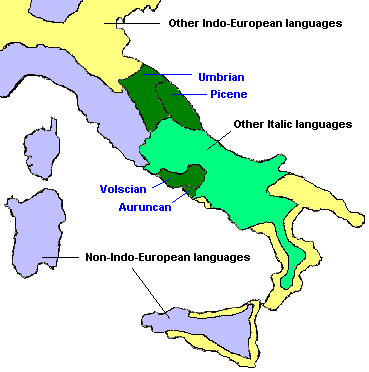- Language Description
- Umbrian Glossary
- Umbrian Alphabet
- Indo-European Chronology (Italic)
- Links
 In
the first half of the 1st millennium, B.C., Umbrians inhabited the northeastern
Italian districts and were in close contact with the Etruscan civilization
along with other non-Indo-European peoples of Italy. This fact was
to make for various sorts of changes in the language which did not take
place in Latin or even in Umbrian's closest relative,
Oscan. Other languages related to Umbrian
were Volscian, Pelignan, Picene
(believed to be the first non-Indo-European tongue to be assimilated into
I.E.) and Auruncan. Some dialects in Central Italy bore some Umbrian features
as well as Latin ones.
In
the first half of the 1st millennium, B.C., Umbrians inhabited the northeastern
Italian districts and were in close contact with the Etruscan civilization
along with other non-Indo-European peoples of Italy. This fact was
to make for various sorts of changes in the language which did not take
place in Latin or even in Umbrian's closest relative,
Oscan. Other languages related to Umbrian
were Volscian, Pelignan, Picene
(believed to be the first non-Indo-European tongue to be assimilated into
I.E.) and Auruncan. Some dialects in Central Italy bore some Umbrian features
as well as Latin ones.
Umbrian phonetics lost some of Indo-European vowels, practically all diphthongs, and it had a strong tendency for disappearance of final consonants. Final -d was lost, s between vowels and in final position became r under the rotacism law (it was much stronger than in Latin). Two strange sounds were invented, which are still being discussed by linguistics: a sibilant which was used instead of k between vowels, and a peculiar sound which was transliterated by Romans as rs - maybe like in Chech diacritical r. This sound was sometimed used in intervocal position (between vowels) instead of original d.
The Umbrian alphabet is likewise of Etruscan origin. The letters T and K served for the /t/ and /k/ sounds as well as the /d/ and /g/ ones. A modified R, much like a capital P, denoted a sound which was transliterated in Latin as RS. One new symbol was used for a sibilant .
Umbrian morphology was much like Oscan, and changes did not influence it. But some linguists note that Umbrian was the most progressive of Italic tongues, one main feature of this being its inclination to lose some flexions and complex verb forms. Umbrian was the first to influence Latin, as it did not disappear until the first centuries A.D.; many guess that this language was one of the main mother tongues of Popular Latin. But Latin after all assimilated Umbrian, and we are able to judge all elements of the language only by using ancient texts, of which the Iguvian Tables are the main source.